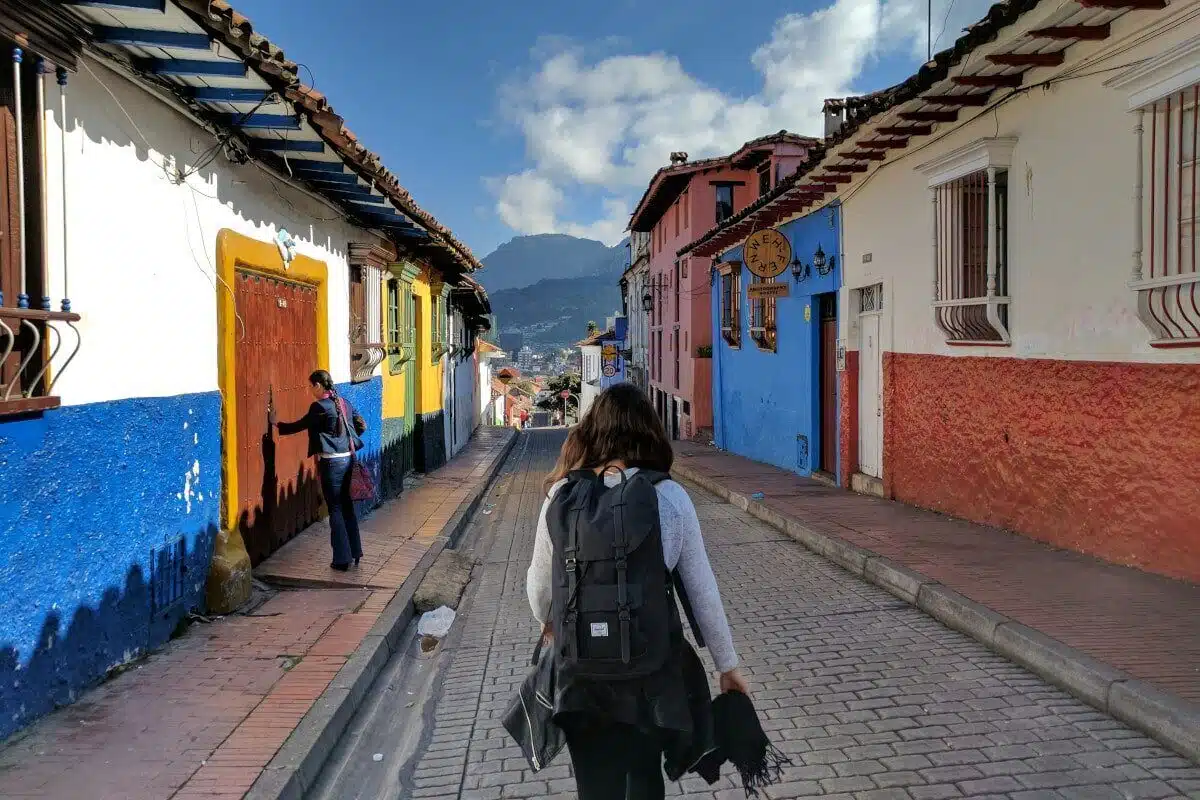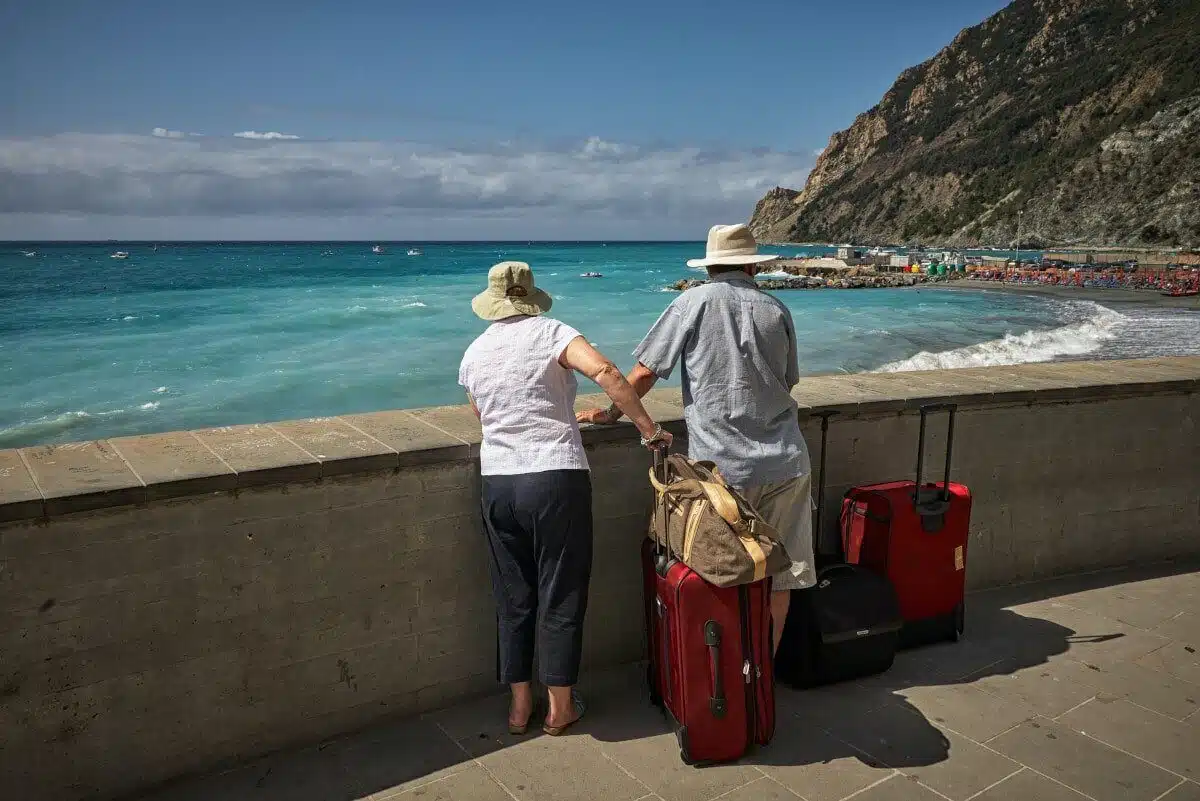Trying to find out about the different types of tourists? I hope this post helps!
News just in:
Not all tourists are made equal!
Sure, we’re all going from place to place to enjoy the various attractions on offer in our chosen destinations.
But everything from our reasons for travelling to our style of travel can vary, right?
So it turns out tourism’s actually this big umbrella term, under which sit all sorts of different types of tourists.
In fact, it can actually get a bit confusing…
From what I can tell, there’s no actual consensus on how many tourism types exist!
Some articles list 3 main types of tourism, others 10, a few make up their own ones for a bit of fun, and I’ve even seen some that detail 60+!
To satisfy my own curiosity and help anyone else who might be looking into this topic, I thought I’d do some digging and put together a post about the main categories of tourism that seem to crop up again and again.
Sound good? Keep reading for a detailed look at 40 different types of tourist and tourism!
Here we go then: 40 different tourism types worth knowing about!
You might like these posts too!
- 10 Primary Disadvantages of Tourism
- A Complete Guide to Eco Travelling
- 10 Best Types of Vacations
- How to Say Thank You Around the World
- 30 Different Types of Travelling
- Comprehensive Guide to Responsible Tourism
- 20 Benefits of Solo Travel
- The Best Jobs for Adventurers
3 Main Types of Tourism
Some sources, like this one, divide the overarching category of “tourism” into three primary forms: domestic, inbound, and outbound tourism.
Let’s go through each one in turn!
First, though, here’s a fun fact: to be classed as any type of tourist, it’s generally accepted that you’re not leaving home to stay in a chosen country for more than a year. Extend your stay beyond 12 months and I’m not exactly sure what you become (a resident, maybe?). Yet, by all accounts, you’re no longer a tourist!
1. Domestic
Domestic tourism’s basically when you visit somewhere within your own country but outside the specific place you live.
Imagine a Brit who lives in London. They’d be classed as a domestic tourist if they left London to explore another part of the UK.
2. Inbound
Inbound tourism’s the opposite.
This, according to the source above, is “the activities of a visitor from outside [their] country of residence”.
So, if that same Brit left the UK to travel around France, or Spain, or anywhere that isn’t England, Wales, Scotland, or Northern Ireland, they’d be classed by their chosen destination as an inbound tourist.
3. Outbound
And, finally, outbound tourism is when you leave your home country to explore somewhere else.
So, technically, you can be an inbound and outbound tourist at the same time!
For instance, the Brit who leaves the UK to go on holiday in France is an outbound tourist from the UK’s perspective and an inbound tourist from France’s.
Which type of tourism most appeals to you? And what type of tourist do you think you are?! Find out in the next section…
4 Types of Tourist?
In some pieces of tourist-related literature (like this one), those 3 official tourism types give way to 4 different types of tourists.
I find these ones far more interesting to think about!
They’re essentially different types of travellers. Learn the definitions and you can start working out which category you (and the people you meet on the road) fit into.
FYI, I’ve taken the following definitions from the source I’ve linked to above.
4. The Drifter
Drifters are tourists who pick novelty over familiarity every single time.
They revel in adventure, immerse themselves in the local community, and, whether they’re alone or in a group, tend to move without a plan or set itinerary.
5. The Explorer
Explorers favour novelty over familiarity too, just not to the same extent as drifters!
Preferring to travel solo, they also enjoy a semblance of comfort, structure, and certainty on the road. If they can see fascinating places with a reliable form of transport, then they’re happy bunnies.
6. The Individual Mass Tourist
The tables turn with individual mass tourists, who prefer familiarity over novelty.
However, they do choose to go it alone, opting for solo travel over group exploration whenever possible. They’ll follow a relatively structured itinerary and stick to certain times in particular parts of town.
7. The Organized Mass Tourist
Finally, there’s the organized mass tourist.
These guys are on the other end of the spectrum to drifters, picking familiarity over novelty every time. They’re the tourists who follow a tour guide whenever possible, try to create and stick to an itinerary, and leave nothing up to chance.
According to the literature, different types of travellers seem to fit into two distinct categories. More on these next…
2 Personality Tourist Types
To confuse things further, you see some sources (like this one) discuss just two main tourist types!
This time, though, the definitions revolve around tourist personalities.
8. Allocentric (AKA “Venturers”)
Allocentric tourists are, according to the above source, “outgoing, self-confident, and adventurous”.
They tend to fly to their country of choice and will pick off-the-beaten-path destinations over more crowded/touristic ones.
From that description, allocentric travellers seem to resemble the drifters and explorers in the previous section. However, that’s very much my own interpretation! Experts in the field of tourism may disagree entirely.
9. Psychocentric (AKA “Dependables”)
As “self-inhibiting, nervous, and non-adventurous”, psychocentric tourists are basically the polar opposite of allocentric ones.
They “often refuse to travel by air for psychological reasons rather than financial of other practical concerns”, preferring familiar destinations to which they can travel by car and that have a solid tourist infrastructure.
Enjoying tour packages and well-organized itineraries, the psychocentric tourist sounds very much like the organized mass and individual mass tourists above.
Time to move onto a long list of the main categories of tourism talked about in tourist circles!
General Subcategories of Tourism
With the technical and official forms of tourism down, let’s move onto the many different categories that tourism boards talk about online!
In alphabetical order, these ones usually revolve around peoples’ reasons for travelling versus their specific personality or style of exploration.
10. Art Tourism
Love going to new places to get involved in the art scene? Maybe you go to art festivals, explore art galleries, or attend specific artistic events.
Whatever the case, you’re officially an “art tourist”.
Even things like going to famous museums and wine tasting events supposedly fall under the bracket of art tourism.
11. Backpacking/Youth Tourism
Sometimes referred to as “youth tourism” because of its typical demographic, backpacking (or backpacker) tourism is basically when you slap your stuff into a backpack and hit the road!
From what I can tell, it’s usually associated with a younger generation and often associated with gap year travel.
12. Budget Tourism
Quick heads up: I’m not sure this is an official type of tourism or one that’s been invented by the international travelling community!
Nevertheless, as someone who travels on a budget all the time, I can vouch for its legitimacy! Budget travel/tourism is the act of exploring on a shoestring. With close ties to backpacking tourism, you try to see and do what you can without having access to huge sums of cash.
Business tourism may be one of the better-known forms of tourism on this list.
13. Business Tourism
Business tourism seems to be one of the largest, most accepted, and most talked about tourism types out there.
It’s essentially when you have to travel for work!
A business traveller might attend meetings, go to trade shows, pitch ideas to international companies, and so on.
14. Cultural Tourism
In contrast to business tourism, the definition of cultural tourism seems to be far more slippery and less agreed upon in the literature.
I guess that makes sense though. After all, defining “culture” itself isn’t easy.
Regardless, the basic principle behind cultural tourism is that you travel somewhere to experience its cultural traditions/activities (whether you’re just watching or actively partaking in them). This might involve going to a religious festival in India or Carnival in Rio de Janeiro, Brazil, for example.
15. Dark Tourism
Anyone who’s watched the “Dark Tourist” TV show will have a solid grasp of dark tourism already!
For anyone who’s new to the whole shebang, though, this is the slightly shady act of exploring places associated with death and/or tragedy.
Two examples would be:
- Going to Cambodia to see the Killing Fields, or to
- Mexico for El Dia de los Muertos (the Day of the Dead).
…As an aside, attending Mexico’s Day of the Dead celebrations would probably constitute cultural tourism as well.
Dental tourism is one type of tourism that fewer people know about, but that’s becoming increasingly popular.
16. Dental Tourism
Dental tourists are people who travel to a foreign country to receive dental treatment.
Sounds crazy, right?
However, it starts making far more sense when you realize you can get really high-quality dental care at a fraction of the cost overseas!
17. Disaster Tourism
Disaster tourism reminds me a bit of dark tourism. This time, though, it involves visiting places that have suffered some sort of environmental disaster.
Whether the disaster’s man-made or natural, people decide to take a look at the aftermath and it isn’t long before businesses start cropping up to cater to them.
18. Ecotourism
Ecotourism’s talked about a lot these days- especially among avid travellers who can’t imagine life without adventure, yet wish to preserve and protect the incredible places they’re lucky enough to visit.
Alas, with jet fuel often required to get efficiently from one place to another, living by these ideals is easier said than done!
Ethical dilemmas aside, ecotourism’s when you visit natural areas responsibly.
In other words, you travel in a way that both conserves the environment and benefits (instead of hinders) the local population.
Want to teach overseas? You’ll be partaking in educational tourism!
19. Educational Tourism
Often shortened to “edu-tourism”, this type of tourism involves travelling to a foreign country for educational purposes.
The education itself may involve learning a language or learning information on the country’s history, culture, or social practices. Specific examples include going on a school trip or going to study abroad.
20. Ethnic Tourism
An ethnic tourist is someone who chooses to experience with their own two eyes the lifestyle, customs, and practices of another culture.
Sounds similar to cultural tourism, right?
However, according to this source, ethnic tourism involves a closer, more direct, and “intimate” glimpse into another culture, whereas cultural tourism involves a more indirect manner.
21. Event Tourism
As far as I can tell, event tourism involves hosting and marketing events of one form or another that function as specific tourist attractions.
In other words, you hold an event to:
- Encourage people to visit your country and
- Shed your country in a positive light.
An event tourist is someone who’s left their country of origin to visit that destination for that event (be it for business or pleasure) and stayed overnight. If they don’t stay, then they’re deemed an “event visitor”.
You can find more information here.
Family tourism’s another commonplace type of tourism worth knowing about.
Enjoying this post about the different types of tourism? You might also like these…
- 50 Fascinating Facts About Travel
- 85+ Road Trip Trivia Questions & Games
- 75 Essential Things to Pack for Travel
- Key Features of the Experience of Travel
- 100 Reasons I love to Travel (& You Will Too)
22. Family Tourism
Family tourism seems like a fairly vague and overarching term that involves all forms of tourist activity done as a family unit.
For example, you might travel somewhere with your family and go to a theme park, or try any other kid-friendly attractions in the area.
Family tourism would also include paying a visit to your friends and relatives overseas.
23. Festival Tourism
This type of tourist is nice and simple:
A festival tourist’s someone who travels somewhere specifically to attend a festival!
Whether it’s Glastonbury, Burning Man, Tomorrowland, or any of the other countless festivals happening around the world, attending them all constitutes festival tourism.
24. Food/Gastronomy Tourism
Travelling somewhere to sample its gastronomical delights and learning a thing or two about the culture as a result?
Well, you’re officially a food tourist!
Food tourism is the arena in which you’ll operate. You could be taking a cooking class, visiting local producers, sampling the street food, or taking a local wine tour.
Of all the tourism types on this list, heritage/historical tourism is one of my personal favourites.
25. Health/Medical Tourism
Medical tourism’s similar to dental tourism. This time, though, you’re travelling abroad to get treatment of the medical instead of the dental variety!
It can work in two ways.
- First, someone from a less-developed country may travel to a more developed one in order to access treatment that’s unavailable at home.
- Second, someone from a more developed country may travel to a less developed one to benefit from cheaper treatment.
26. Historical/Heritage Tourism
In a nutshell, historical tourism (otherwise known as heritage tourism) involves going overseas to enjoy its historical sites, sights, and attractions!
It’s the person who visits Rome to explore the Colosseum, Egypt to see the Sphinx, or Peru to visit Machu Picchu. Sure, you enjoy the other tourism attractions in these places as well, but your primary focus is on the history.
Read more about historical tourism here.
27. Hobby Tourism
As you’d expect, hobby tourism is when you travel alone or in a group to watch or partake in your particular hobby of choice.
Things like “football tourism” (e.g. going somewhere to watch your favourite football team play) and “music tourism” (e.g. going somewhere to see your favourite artist perform live) are two popular examples that fit within this overarching category.
International tourism is one of the main types that crop up again and again.
28. International Tourism
Another wide, general, and overarching category of travel, international tourism is the opposite of domestic tourism (discussed above):
You cross national borders to visit and explore your given destination.
29. Leisure Tourism
To borrow a definition from USA Today, leisure travel involves:
“Travel in which the primary motivation is to take a vacation from everyday life.”
So, the leisure tourist might be staying in resorts, dining out, lazing on beaches, going on guided tours, and doing whatever they can to take a much-needed break from the norm.
30. Local Tourism
Local tourism basically involves spending your time and money in foreign destinations as one of the locals would!
You’re shopping in local markets, paying a local taxi driver for a ride instead of a big international company like Uber, dining in local establishments and partying where the locals go.
The goal? To:
- Experience what life in this destination’s really like, and
- Spend your cash in a way that supports the local population.
Want to learn more about a similar topic? Here’s my guide to local travel.
Leisure tourists look for an escape from everyday life and see travel as the perfect solution.
31. National Tourism
Remember the definitions of domestic and outbound tourism I talked about before?
Well, according to the World Tourism Organization, national tourism is a category of tourism that encapsulates them both.
In their words:
“That is to say, the activities of resident visitors within and outside the country of reference, either as part of domestic or outbound tourism trips”.
32. Nature Tourism
Nature tourism’s another straight-forward form of tourism to wrap your head around:
You simply travel somewhere to revel in its natural, undeveloped areas and/or to enjoy the native wildlife on offer there!
33. Recreational Tourism
I’ve seen recreational (or recreation) tourism defined in two different ways.
The first (and most common) is that it involves travelling in order to participate in recreational activities- usually in nature- or to be a participant. Golf, fishing, hiking, and kayaking are a few examples.
The second, less common description (that nonetheless ranks at the top of Google results) is that it’s “the movement of people in their free time in the aims of rest required to restore the physical and mental strength of a person”.
Love nature and want to spend more time outdoors? Nature and recreational tourism are two different types of tourism worth looking into!
34. Religious Tourism
Are you a person of faith? Are you travelling alone or in a group to do something related to your religion?
Well, technically speaking, whether you’re going on pilgrimage, travelling as a missionary, or simply having fun, you’d be considered a religious tourist.
Heads up, you’ll also see religious tourism referred to as faith tourism.
35. Shopping Tourism
A relative newbie as far as the different types of tourists go, shopping tourism is exactly what you’d expect it to be:
Where the purpose of travelling to new places revolves largely around the desire to buy stuff. So, whether you’re going to London, Paris, or New York, your primary focus is on the goods you can acquire there.
36. Social Tourism
A more complicated and nuanced category of tourism, examples of social tourism include helping a charity build schools somewhere overseas, or teaching English to students there, and so on.
Simply put, the central focus of travel here isn’t just on personal pleasure. You’re trying to do something good for local communities in which you’re exploring.
Third-age tourism is another key tourism category in the travel industry! First, though, let’s talk about sports tourism…
37. Sport Tourism
Going somewhere new to participate in or watch a sporting event?
Well, you’re a sport tourist!
Imagine going overseas to see the next football/soccer world cup or to be in the stands at the next Olympics. This is sports tourism in its purest form. However, it could also involve going somewhere to train as a yoga instructor, or to learn martial arts.
38. Third-Age Tourism
Third-age tourism is also known as senior tourism or “silver tourism”.
This is the section of the tourist industry aimed at people who are going somewhat “grey around the edges”; who may have retired and now have expendable income and lots of free time on their hands.
So, if you love to travel and are getting a little longer in the tooth, then you’re probably classed as a senior tourist.
39. Urban Tourism
Another type of tourism for which you can probably guess the definition, urban tourism involves travelling to and around non-rural destinations.
This is the weekend trip to London, or the short break in Berlin.
You’re exploring the cities or towns, immersing yourself in the myriad metropolitan attractions on offer there.
40. Winter/Ski Tourism
Love cutting lines down powdered peaks? Well, you’re already familiar with winter/ski tourism!
From getting involved in winter sports (like skiing, snowboarding, or ice-skating) to watching them from the side-lines, a winter tourist travels to enjoy all-things cold and snow/ice-covered.
Remember (and try!) These Tourism Types
There you have it then: 40 different types of tourists.
As you can tell, although most of us have a basic definition of “tourism” in our head, the industry itself breaks down into dozens of individual tourism types!
If you’ve been trying to gain a greater understanding of these different categories of tourism, then I hope this post has helped!
Know of any other types of tourist for me to add to the list? Drop a comment below!














Wonderful explanation. Would like to add another one that is combination of above mentioned types.